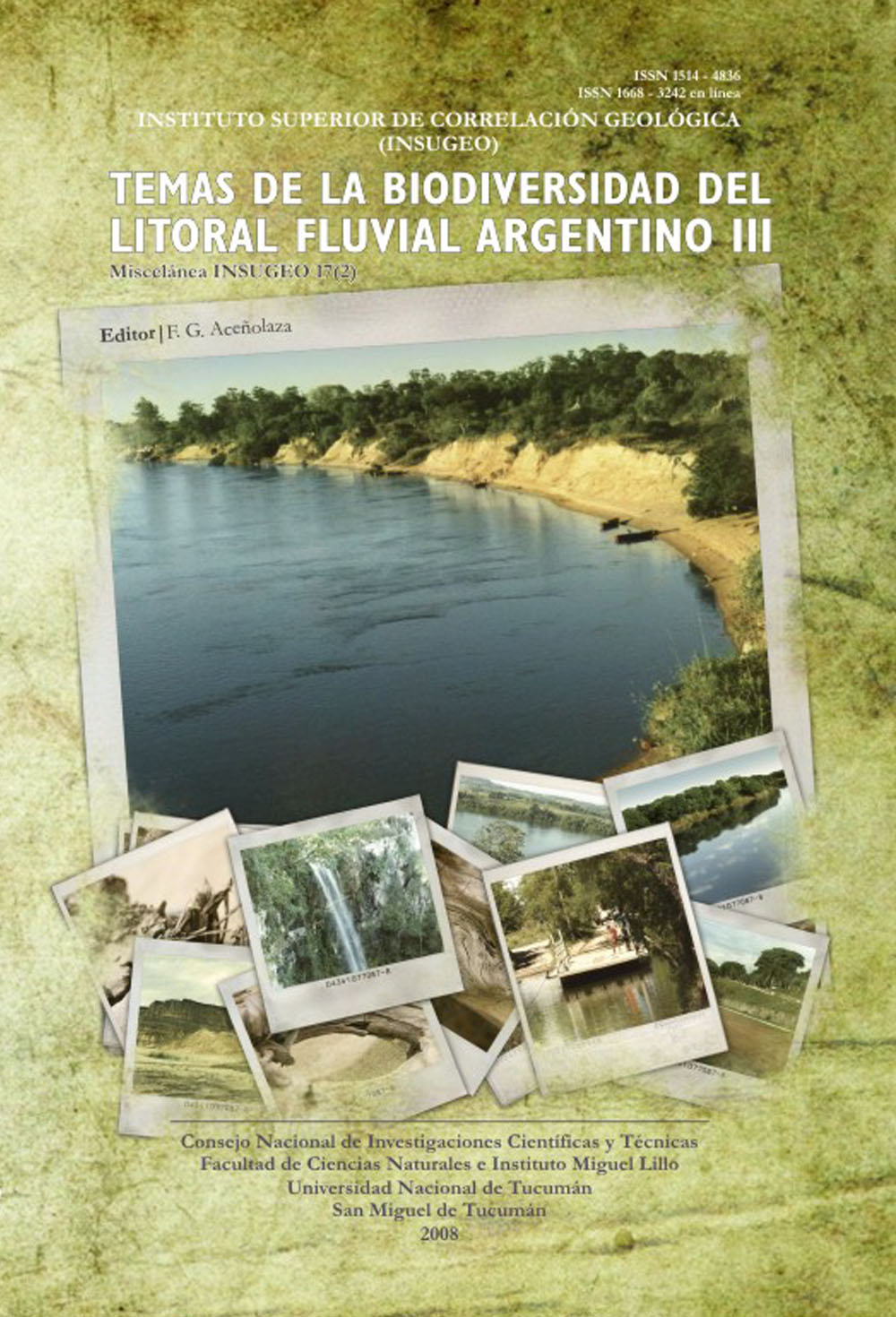Miscelánea 17 (2)
variaciones Interespecíficas entre las especies del género Belostoma en ambientes acuáticos de la provincia de Corrientes
Cristina, Armúa de Reyes | Arturo I. Kehr
Descargar trabajo en formato PDFResumen
ECOLOGÍA DE COMUNIDADES: DIVERSIDAD, ASOCIACIONES Y COVARIACIONES INTERESPECÍFICAS ENTRE LAS ESPECIES DEL GÉNERO BELOSTOMA EN AMBIENTES ACUÁTICOS DE LA PROVINCIA DE CORRIENTES.- Los integrantes de la Familia Belostomatidae ocupan áreas definidas tanto en el Hemisferio Occidental como en el Oriental (excepto Europa y Norte de Asia). Los principales objetivos fueron 1) Determinar la composición específica de la comunidad de belostomátidos, en dos tipos de ambientes acuáticos contrastantes, uno permanente y otro temporario considerando la diversidad y analizando sus fluctuaciones en el tiempo, y 2) Estudiar las asociaciones y covariaciones interespecíficas entre las especies del gro. Belostoma. Los muestreos fueron llevados a cabo durante tres años (diciembre de 1995 hasta diciembre de 1998). La diversidad fue calculada mediante el Índice de Shannon utilizando el logaritmo natural para su obtención. Las asociaciones interespecíficas fueron analizadas mediante el Índice de Jaccard y las covariaciones interespecíficas se registraron mediante la correlación de Spearman. Las especies del género Belostoma halladas en ambos ambientes fueron: B. elegans Mayr, B. micantulum Stal, B. elongatum Montandon, B. dentatum Mayr, B. dilatatum Dufour, B. oxyurum Dufour, B. plebejum Stal. En tanto que las especies B. candidulum Montandon y B. orbiculatum Estévez y Polhemus, solo fueron recolectadas en el ambiente permanente. Las especies B. elegans, B. micantulum y B. elongatum, por su constancia y representatividad, pueden ser consideradas centrales para los dos tipos de ambientes. Tanto en el ambiente permanente como en el temporario los aspectos inherentes con las relaciones interespecíficas fueron marcadamente diferentes entre cada año. Eso se debió fundamentalmente a la gran diferencia registrada en las lluvias caídas entre diciembre de 1995 y diciembre de 1998. En cuanto a las covariaciones entre las especies halladas en el ambiente permanente, considerando a los tres años de estudio, la especie B. elegans se halló relacionada positiva y significativamente con B. micantulum y B. dentatum; al mismo tiempo se observaron covariaciones negativas y significativas entre B. elegans y las especies B. dilatatum y B. candidulum. En el ambiente temporario, fue registrada una covariación positiva entre B. elegans y B. micantulum; al mismo tiempo fue registrada una covariación negativa entre B. elegans y B. dilatatum.
Abstract
COMMUNITY ECOLOGY DIVERSITY, ASSOCIATIONS AND INTERSPECIFIC COVARIATIONS AMONG THE SPECIES OF GENUS BELOSTOMA IN AQUATIC ENVIRONMENTS THE PROVINCE OF CORRIENTES.- The members of the Belostomatidae Family occupy defined areas so much in the Western as in the Eastern Hemisphere (except Europe and Norte of Asia). The main objectives were 1) to determine the specific composition of the community of belostomatids, in two different aquatic environments, one permanent and another temporary for analyzing the diversity in different time, and 2) to analyze the interspecific associations and covariations of the species belonging genus Belostoma. The samples were carried out during three years (December of 1995 until December of 1998). The diversity was calculated by means of the Index of Shannon using natural logarithm. The interspecific associations were analyzed by means of the Index of Jaccard and the interspecific covariations were registered using Spearman correlation. The species of the genus Belostoma found in both environments were: B. elegans Mayr, B. micantulum Stal, B. elongatum Montandon, B. dentatum Mayr, B. dilatatum Dufour, B. oxyurum Dufour, B. plebejum Stal. Nevertheless the species B. candidulum Montandon and B. orbiculatum Estévez and Polhemus, only were collected in the permanent environment. Owing to the abundance and continues presence, the species B. elegans, B. micantulum and B. elongatum can be considered as core species for both types of environments. The rainfall was changing among the three years, being greater the amount toward December 1998. The interspecific relationships were different every year. In the permanent environment, considering the three years, B. elegans was associated positively with B. micantulum and B. dentatum; at the same time were observed negative covariations between B. elegans and the species B. dilatatum and B. candidulum. In the temporary pond was registered a positive covariation between B. elegans and B. micantulum. Also was registered a negative covariation between B. elegans and B. dilatatum.






